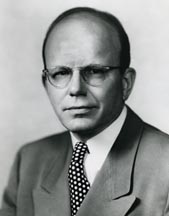

Books of the 20th Century Exhibition |
||||||||||
 |
|
|||||||||
Question from I. Keith Tyler: Two people have submitted questions that concern a recent article. In February of 1970 issue of School Review, Herbert M. Kliebard wrote an article on the Tyler Rationale. He seems to suggest that the Taylor Rationale is outdated and needs discarding or upgrading. What were your reactions to the Kliebard argument? Response from Ralph W. Tyler: I am glad, of course, to see persons in major institutions concerned with the problem of curriculum development and the rationale or general outline of procedures for attacking the problems. But I am disappointed in this article because it does not appear that Mr. Kliebard has read the syllabus, Basic Principles of Curriculum and Instruction, very carefully. He conceives, Kliebard conceives, of this as being a theoretical formulation of what a curriculum should be. Or, as it states quite clearly in the syllabus that this is an outline of kinds of questions that the students in the curriculum class and in my class over the years (these were people coming from very different backgrounds: nurses from the schools of nursing seeking to develop or improve curricula for the preparation of people in their field; persons in elementary schools trying to work on curriculum problems there; persons in schools of engineering and so on around) so that the common effort in this class was to say: however you perceive to build your curriculum, you must deal with certain basic questions: what is to be taught? the means by which the education or learning is to go on? the way in which is to be organized to increase its accumulative effect? and how you are going to tell whether is working and where it is having difficulty so that improvements are made? These are the four basic questions, and it is quite clearly stated both in the syllabus and later that, first, that this is an outline of things to consider and not an answer to these questions and, second, that there are other possible approaches which the students are encouraged to use if they wish to but these pretty much encompass the kinds of questions that most curriculum programs have tried to deal with in the past. Now, I have sought to understand why Kliebard fails to makes this distinction. And I think it is because he is looking for a curriculum theory that tries to answer the questions rather than to raise them. And, as I considered possible analogies, it seemed to me that it was as though he were saying of an architect, what is your blueprint for the building that I need to have? Or, where as my syllabus was a checklist to be used in connection with architects to say whoever prepares the blueprint must consider that there was have to be some basic foundation, there will need to be a consideration of the floors themselves and the space, there need to be a consideration of landscaping. The kinds of things that a blueprint should include will have to be considered. But the syllabus was not any attempt to answer the question. Really, the syllabus grew out of the belief, which seems to be rather current in curriculum thinking today, that students should be encouraged to enquire and to work out answers to their own questions rather than believing that a faculty member should work out the ideal solution to all questions and seek to indoctrinate this with his students. Interviewer: I. Keith Tyler; date: circa 1970 |
||||||||||
to return to the Ralph W. Tyler Exhibition |
to return to the Books of the 20th Century Exhibition |
|||||||||
![]()

an institutional member of the International Coalition of Sites of Conscience
Museumofed@gmail.com

